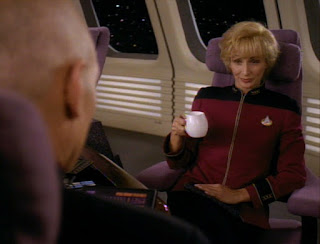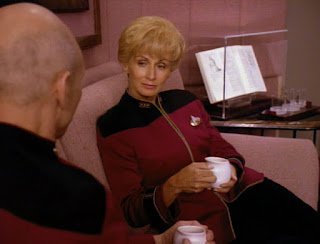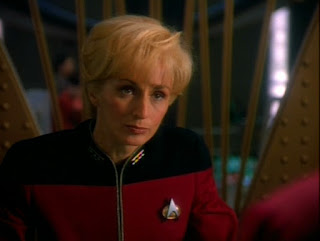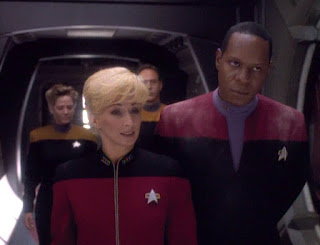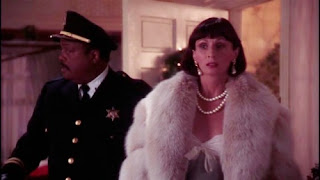As The Official Starships Collection bows out in a matter of weeks with its 180th issue, Eaglemoss are already setting out to new frontiers with their Star Trek Online Starships series.
The first two issues are out right now featuring the USS Gargarin and the USS Chimera.
As it's the opening salvo from this new collection, let's dissect this from a box level down. First of all, the packaging has stepped up to the mark and away from the generic blue sleeves from The Official Starships Collection. Taking instead a line from the busts, the boxes are a full six sides with a windowed front. The sides are decked out with info on what's contained within and for those looking to line it all up as a "bookshelf" series, the spine side carries the issue number and ship detail.
As it's the opening salvo from this new collection, let's dissect this from a box level down. First of all, the packaging has stepped up to the mark and away from the generic blue sleeves from The Official Starships Collection. Taking instead a line from the busts, the boxes are a full six sides with a windowed front. The sides are decked out with info on what's contained within and for those looking to line it all up as a "bookshelf" series, the spine side carries the issue number and ship detail.
All in all it's a big move away from the plastic bag ship and mag combination we've seen for the last seven years and instantly looks a darn sight more professional and inviting. On the back - and not therefore not taking up any unnecessary magazine space - is a preview of the upcoming issues, naming a few more than there are pictured.
 This is definitely a positive shift for Eaglemoss who are also notably stamping it with their Hero Collector brand. Also a move in keeping with the Busts and Discovery collections is the downsizing of the magazines to fit into those boxes. Good move for space saving after 180 larger magazines but dead fiddly and certainly the text is harder to read. More on the mags at the end.
This is definitely a positive shift for Eaglemoss who are also notably stamping it with their Hero Collector brand. Also a move in keeping with the Busts and Discovery collections is the downsizing of the magazines to fit into those boxes. Good move for space saving after 180 larger magazines but dead fiddly and certainly the text is harder to read. More on the mags at the end.
Ok, here’s issue one’s lowdown. The USS Gagarin is a visually upgraded version of the Shepard Class from Discovery, offering not just a 25th Century structural makeover but also a striking new paint job.
Utilising the same model sizing as The Official Starships Collection, the Gagarin has a set of crisp lines and immediately you realise that this is as close as close as close as you could get to the craft on Online. Why? Because the CG models have always been Eaglemoss’ preferred media of choice when it’s come to creating their starships series and was most evident when you compared the Enterprise ships to any of the series that preceded it.
 That accuracy is continued here, beginning with NCC-97930. Take a look firstly at the circular primary hull with its detailed panelling - there’s a lot of it and in comparison to the TV shows, this ship doesn’t carry those ramrod straight lines emanating from the bridge module out to the edge. It’s a more curved pattern, weaving across the deck symmetrically along the dorsal centre line of the hull. The paintwork is very Online, taking the choice to head for the sharply contrasting white and black blocking. It’s simple and effectively painted on but raises your awareness of the very average decalling particularly when it comes to the ‘slipped’ markings indicating the ends of the dorsal phaser arrays.
That accuracy is continued here, beginning with NCC-97930. Take a look firstly at the circular primary hull with its detailed panelling - there’s a lot of it and in comparison to the TV shows, this ship doesn’t carry those ramrod straight lines emanating from the bridge module out to the edge. It’s a more curved pattern, weaving across the deck symmetrically along the dorsal centre line of the hull. The paintwork is very Online, taking the choice to head for the sharply contrasting white and black blocking. It’s simple and effectively painted on but raises your awareness of the very average decalling particularly when it comes to the ‘slipped’ markings indicating the ends of the dorsal phaser arrays. The more distinctive feature than its primary hull though are the split pylons connecting the main body to the pair of warp engines. They don't run parallel to each other with the lower sweeping back while the top arm runs straight across. The pylons again continue the black/white Online colour scheme and a slight angle adjustment means that the engines sit just a fraction above the primary hull. The crossbar upper pylon is detail heavy with further contrast panelling as well as ship registry and red striping, both of which are placed perfectly. The lower pylon is perhaps a tad more interesting with a central slit cut into the metal drawing your eye to the black edging of the upper arm. It does feel that the design has some space to breathe here after the onslaught of colour and intricate decalling of the saucer.
 The warp engines themselves attach at two points to the unique double pylon concept and also feature a very unusual design. Angled from front to back as though heading out to a distant vanishing point, the front section is capped with a translucent bussard collector . Now on mine, the starboard collector wasn't attached firmly and just came away from its slot so I'm not hugely thrilled it's another minor repair job.
The warp engines themselves attach at two points to the unique double pylon concept and also feature a very unusual design. Angled from front to back as though heading out to a distant vanishing point, the front section is capped with a translucent bussard collector . Now on mine, the starboard collector wasn't attached firmly and just came away from its slot so I'm not hugely thrilled it's another minor repair job.The rest of the engines have the stripes of the Starfleet pennant top and bottom plus the full item on the sides including more ship registries. It's the back of the units where the design goes a little funky with a split/forked arrangement that includes warp field grilles along the interior edges.
The ship design and in particular the attention to getting the pylons correct has meant in turn that the warp nacelles have remained parallel to their tips. The design and execution of the panel lining here is clean and remains in line on the two prongs of the distinct design. For me, it's the back end where this class really works visually. The saucer is just too busy, there's a lot of shape and colour while the pylons and engines seem more considered and simply painted allowing for the design to come through more effectively.
 The red decals around the lifeboat pod hatches are in contrast a lot more in sync with the hull details as are the trimmings around the outer extremes of the saucer and also around the bridge module. What does let it down is the blotchy ship name just above the ok ship registry. While the latter is in a bigger font, the name has lost a little definition in the shape of the ‘A’s and the ‘G’s that sounds ruin the effect.
The red decals around the lifeboat pod hatches are in contrast a lot more in sync with the hull details as are the trimmings around the outer extremes of the saucer and also around the bridge module. What does let it down is the blotchy ship name just above the ok ship registry. While the latter is in a bigger font, the name has lost a little definition in the shape of the ‘A’s and the ‘G’s that sounds ruin the effect.The bottom of the saucer is perhaps even more cluttered than the top with the continuation of the black and white scheme but the window painting on the black sections does make it appear that the coating is flecked or damaged. Once more, the decals around the lifeboat hatches on the interior are spot on while those lining the outer edge are painted very precisely in line with the raised "blips" on the hull.
The central strip is also just as well completed with the key feature here being the blue, recessed and almost invisible deflector dish which seems to have its own "barrel" if you will that runs down the middle of the ship. To be fair it's as filled out as the top half of the saucer so the utilisation of space on the Gagarin has been used to a premium although at times it seems there's detail for the sake of detail instead of putting in a few breaks!
As an upgraded design from Discovery's Shepard Class it's ok but not one that really strikes home the 25th Century out of the box thinking that echoes from the digital realm of Star Trek Online - but we'll see that in issue two.
 As an opener the model is well detailed, given a good, clean paintjob and is extensively detailed on every surface to recreate the starship as it is in the game. While I'm not totally familiar with the vessel, the finished product looks awesome probably due to that double pylon spin.
As an opener the model is well detailed, given a good, clean paintjob and is extensively detailed on every surface to recreate the starship as it is in the game. While I'm not totally familiar with the vessel, the finished product looks awesome probably due to that double pylon spin.Issue one, a mini-mag included inside the model bx, sets the standard for future issues with a run through of the in-universe nature of the Gagarin plus it's development from the 22nd Century "classic". The pictures - a lot smaller than I'm used to with the bigger editions of the Official Starships line - are extensive with multiple angles of the ship, showing off its key elements alongside some fine plan views which are almost devoid of any callout details.
What does step this issue up however are the Design and the Yard 39 features explaining how the ship came to be in the game both from the real world slant and then from the historical background linking the ship to its "lost" past as part of an abandoned set of ships that could not be reached due to spacial phenomenon. It's just odd enough to work as a concept and shows some of the thinking behind the online game allowing players and fans access to a ton of ships from different eras of Star Trek while also remaining true to the 25th Century setting.
 While the USS Gagarin exemplifies the visual changes that have made Online ships so distinctive and contrasting to their TV counterparts, the USS Chimera NCC-97400 goes back to a tried and tested formula. Commanded by one Ferengi called Nog, the quad-warp-engined starship cuts a sharp look as part of the digital fleet.
While the USS Gagarin exemplifies the visual changes that have made Online ships so distinctive and contrasting to their TV counterparts, the USS Chimera NCC-97400 goes back to a tried and tested formula. Commanded by one Ferengi called Nog, the quad-warp-engined starship cuts a sharp look as part of the digital fleet.Carrying that familiar grey overcoat trimmed with black, this model looks not dissimilar to the USS Prometheus from the top. Again heavy on the deflector grid panel lines as with the Gagarin, the Chimera places itself firmly as a ship ready for battle with a tight profile, swept pylons, entombed bridge and chunky yet streamlined nacelles to finish her off.
The detail on her is very good, relying more on the paint to mark out distinctive features including the curved edge concealing its "devastating" Phaser Lotus. This does, for someone who's not dived that deep into the Online pool, seem like a gimmick and half that's just a step beyond the USS Prometheus' Multi-Vector Assault Mode but hey, different timeline, different theories so who am I to argue against it.
 What I do like about this is the placement of the impulse engines to the back of the engine pylons and Eaglemoss have managed to paint them in pretty perfectly even though it's an incredibly thin edge to use. The warp engines themselves are surprisingly well built with two sections in each of the four modules being completed in translucent plastic - the bussard collectors to the front and the blue field grilles to the rear. There's even a sliver of blue across the centre if you look closely and these might be the best production engines on any ship since these collections began. Honestly, these are a real work of art and model construction - and they're very solid as well so top marks for effort and accuracy.
What I do like about this is the placement of the impulse engines to the back of the engine pylons and Eaglemoss have managed to paint them in pretty perfectly even though it's an incredibly thin edge to use. The warp engines themselves are surprisingly well built with two sections in each of the four modules being completed in translucent plastic - the bussard collectors to the front and the blue field grilles to the rear. There's even a sliver of blue across the centre if you look closely and these might be the best production engines on any ship since these collections began. Honestly, these are a real work of art and model construction - and they're very solid as well so top marks for effort and accuracy.Also take note of that central hump. Not only does it demonstrate a more logical way to protect the bridge than leave it prominently out in the open but also leads back to the well-executed inclusion of the shuttlebay and landing pad. The decals here even include a microscopic ship registry - again, a fine attention to getting these screen accurate.
The decalling overall is inspiringly accurate for an Eaglemoss piece with the lifeboat hatches in alignment and the Starfleet pennants on the sides of the lower hull and warp engines also being well defined. The latter also includes another small version of the ship name and registry.
Now the underneath of the Chimera is not what you might expect. Rather than a smooth raked back finish sliding nicely towards the rear we have a gaping maw of a deflector dish that drops sharply back into the secondary hull. The solid single tone base paint scheme is augmented with darker grey panelling and a wide move right across the ship is to decal on the windows to the smooth surface rather than dipping the hull and having them nearly be aligned to the right spot. For the bulbous secondary hull especially, this move has worked perfectly allowing the whole of the section to be fully realised without ruining the overall effect. Minor grumble - one of the red curves marking the end of the phaser bank here does appear to be off-centre but I really had to look for it.
 The oversize secondary hull does sweep back up just as abruptly as it drops but this time is broken by the white doors of the main shuttlebay which juts out in the opposite direction to the quantum slipstream lump at the front of the main deflector. While the Chimera is unusual, the design balances itself out around this bottom-heavy concept that, for all intents, still looks incredibly deadly and a natural progression down the line of quad-engined starships for the 25th Century Online.
The oversize secondary hull does sweep back up just as abruptly as it drops but this time is broken by the white doors of the main shuttlebay which juts out in the opposite direction to the quantum slipstream lump at the front of the main deflector. While the Chimera is unusual, the design balances itself out around this bottom-heavy concept that, for all intents, still looks incredibly deadly and a natural progression down the line of quad-engined starships for the 25th Century Online.These magazines are a real eye-opener for someone who's fairly inexperienced with the Online advances and they come at the designs from two angles - that of the real world work from the artist who brought it about and then the understanding of its features and reason to be from the in-universe Star Trek perspective. These are great reads accompanied by some very realistic plan views including the now familiar fleeting nod to parts of the ship (but actually here they make sense!).
In issue two we get to explore the processes behind the development of this ship as a reward for lifetime players before turning to a biographical article on the career of Captain Nog following his time at Deep Space Nine. Closing out we have the in-game stats for the class as with the Gagarin.
This is a much better ship with a decent magazine in the package. Stepping away from the contrast paint scheme gives it a more realistic feel than the Gagarin while the design is pure STO built for the game alone. I love the crackers, huge gaping secondary hull and the quad-pod engines - it looks the part and fits perfectly with the game's more aggressive ship battle feature.
The Online collection looks to be an exciting selection to follow and, just from a presentation perspective is a big step up from the original collection we've reviewed for 180 issues. Coming up are a variety of Starfleet ships as well as Klingon, Dominion and Romulan craft from the long-running game.
Enjoyed this article? Why not like and share to spread the word!
Like our page on Facebook
Follow us on Twitter
Find us on Tumblr















